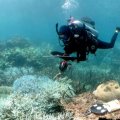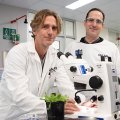A University of Queensland-led international project involving the world's first flight test of a scramjet using a supersonic combustion process is likely to take place in October.
Scramjets are air-breathing supersonic combustion ramjet engines. They are set to revolutionise the launch of small space payloads, such as communications satellites, by substantially lowering costs.
Dr Allan Paull of the University's Centre for Hypersonics said UQ scientists and their collaborators were working round the clock in the $1.05 million project.
"A lot of the elements are coming smoothly together to make the flight possible," he said. "We plan to launch two Terrier Orion rockets fitted with hypersonic air-breathing engine (scramjet) experiments at Woomera, 500km north of Adelaide.
"The rocket launcher has arrived courtesy of British Aerospace Australia. The design of the scramjet is complete following testing in our shock tunnel; the computer program to control the experiment is currently being tested at UQ; and other systems are being tested here and by our partners.
"Wind tunnel testing by DERA, the UK Defence Evaluation and Research Agency at Farnborough, England, has already led to a realignment of the payload with respect to the rocket's fins to improve vehicle stability."
Dr Paull said the HyShot Program would help underscore Australia's position at the forefront of hypersonic technological research. If successful, it would open the door to a new way of flight testing.
"The objectives of the HyShot program can be equated to breaking the sound barrier in flight, but for HyShot, it will be the combustion sound barrier that's broken," he said.
The $1 million program is supported by an international consortium including The University of Queensland, U.S. firm Astrotech Space Operations, DERA (The UK Defence Evaluation and Research Agency), NASA Langley Research Center, The DSTO (Dept. of Science and Technology, Australia), Seoul National University, the DLR (German Aerospace Center) and Australian Space Research Institute (ASRI). Australian firms, Alesi Technologies, AECA, Luxfer Aust. and British Aerospace Australia will assist by providing operational and logistic support. Funding has also been secured from the Department of Industry, Science and Resources, the Australian Research Council and assistance and support from the Ministry of Defence.
The Seoul National University in South Korea has recently joined the international consortium, contributing $50,000 to the project.
Media: Dr Allan Paull, telephone 07 3365 3783, email: allan@mech.uq.edu.au or Jan King, UQ Communications, telephone 07 3365 1120.
Additional contact details:
DSTO Mark Bateup phone 08 8259 7348 mark.bateup@dsto.defence.gov.au Astrotech Morgan Windsor ph 301 982 7876 mwindsor@astrotechspace.com
DERA Dr Terry Cain ph 44 1252 395423, tcain@dera.gov.uk
NASA Dr Randy Voland r.t.voland@larc.nasa.gov
DLR Walter Beck ph 49-551-709 2470/2315 walter.beck@dlr.de
SNU Dr In-Seuck Jeung ph 82-2-880-7387 enjis@plaza.snu.ac.kr
Photographs are available for downloading from the Hyshot folder on the ftp site: http://photos.cc.uq.edu.au/
Enquiries can also be directed to communications@mailbox.uq.edu.au
.jpg)



